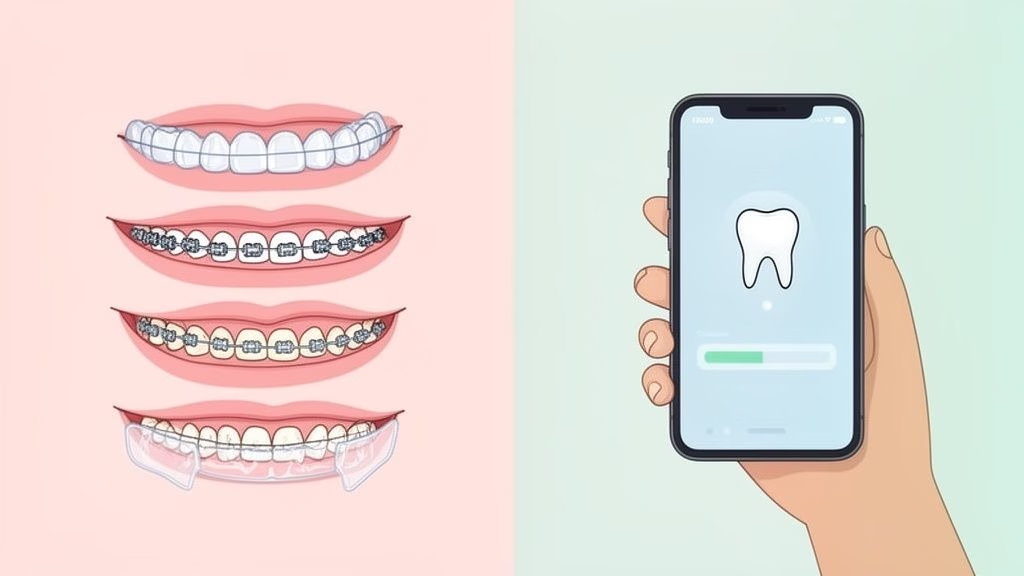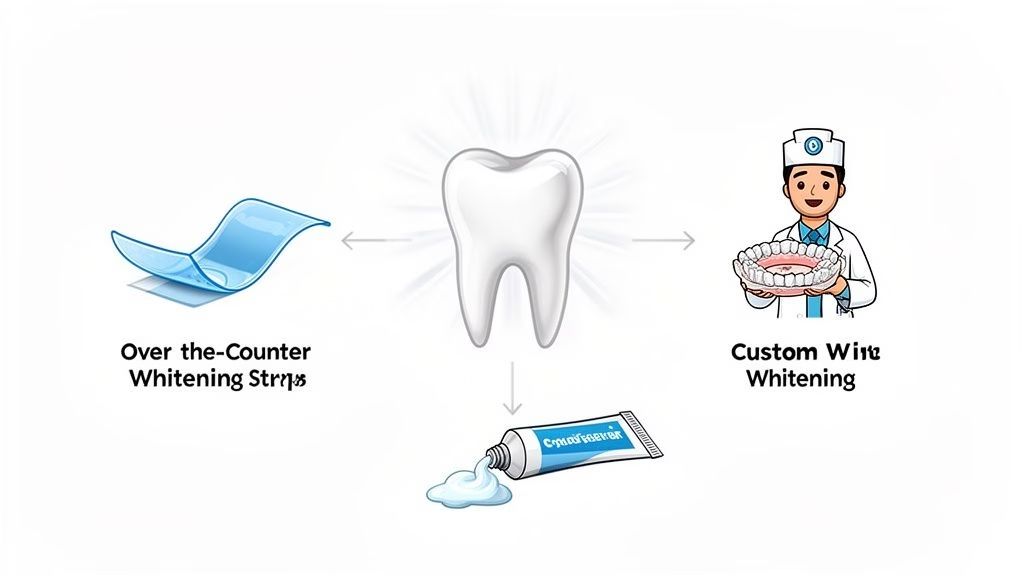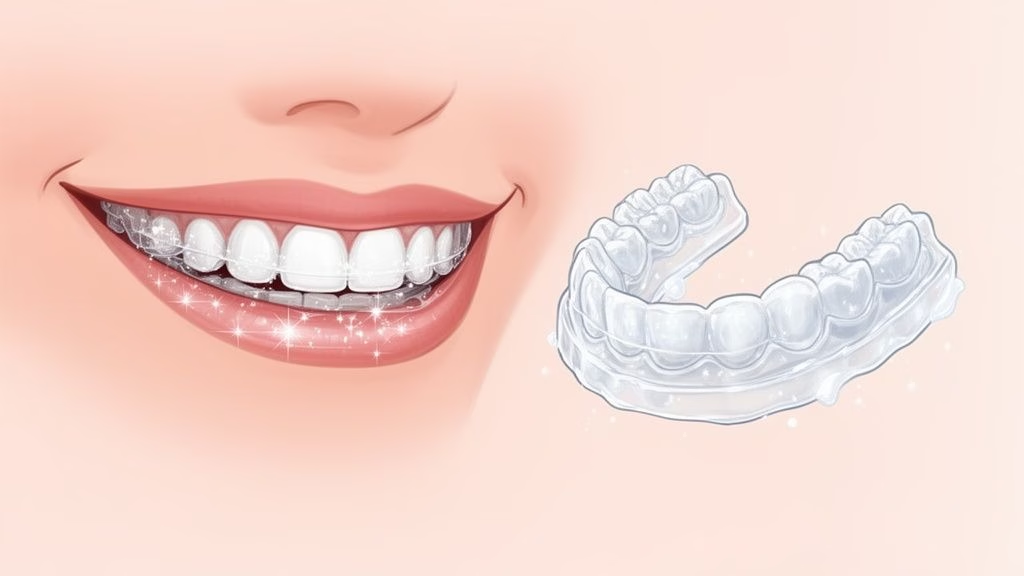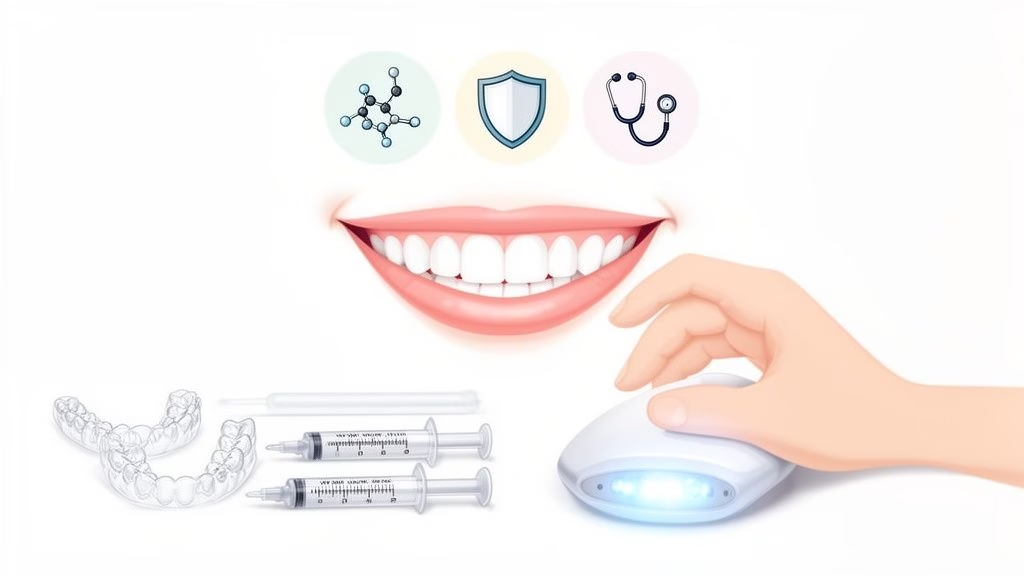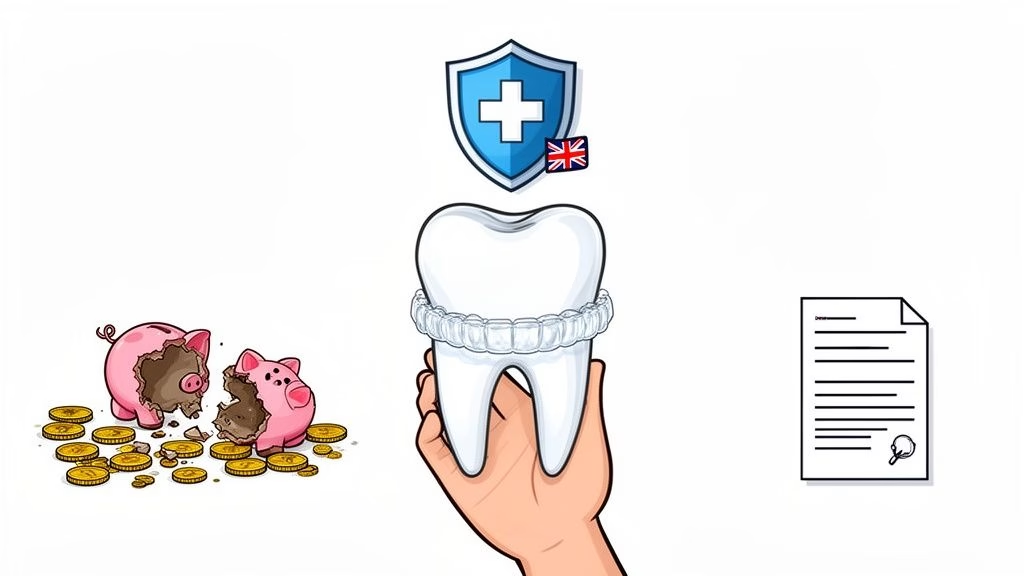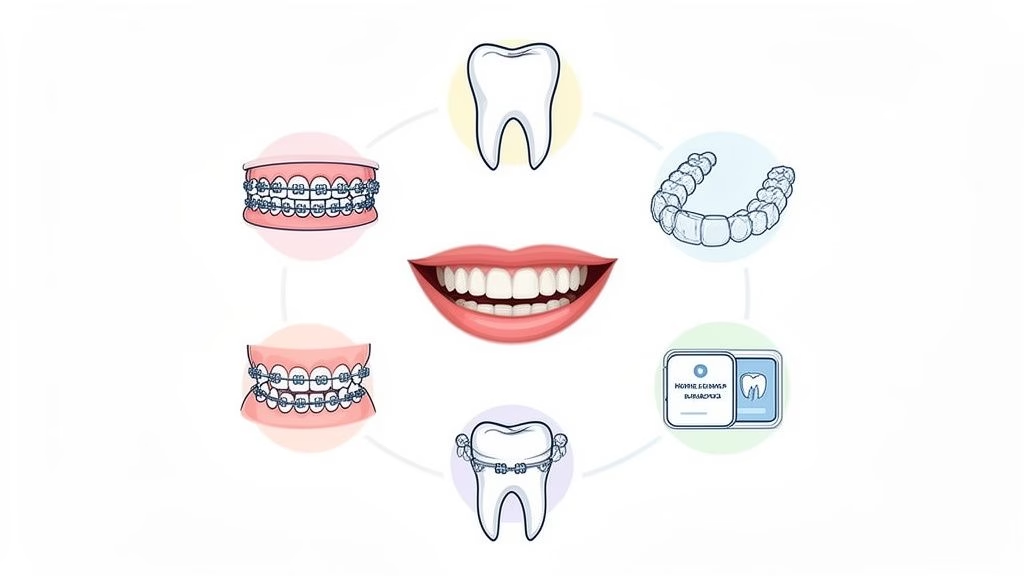A UK Guide on How to Fix Crowded Teeth
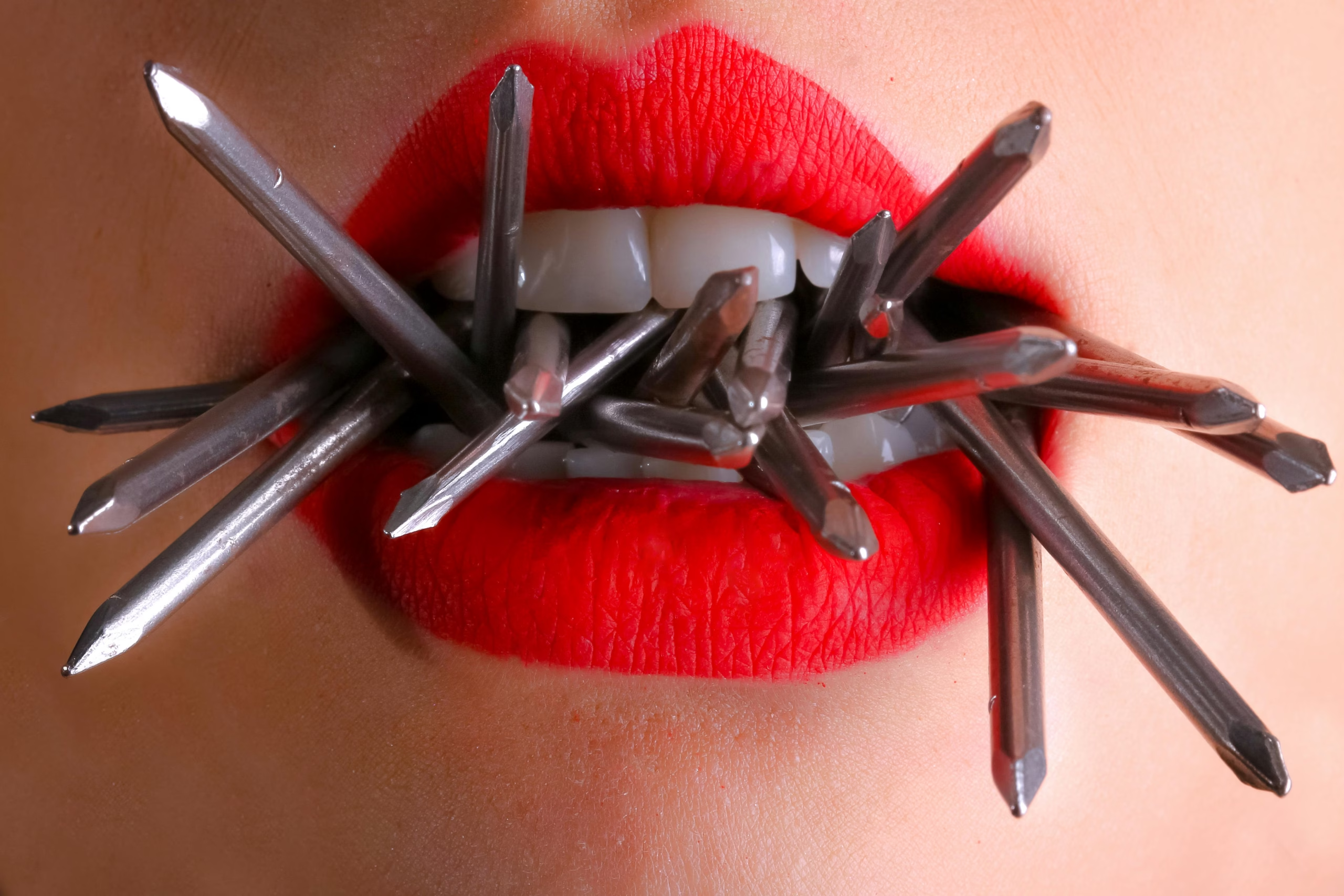
The good news is that you absolutely can fix crowded teeth. Most people find fantastic results with orthodontic solutions like clear aligners or traditional braces, which gently guide teeth into their ideal alignment over time. While surgery exists for the most severe cases, it’s rarely needed. For the vast majority, modern aligners are an incredibly convenient and effective way to get a straighter, healthier smile.
Why Fixing Crowded Teeth Matters for Your Health
If you’re exploring how to fix crowded teeth, you’re probably thinking about more than just aesthetics. Of course, the confidence that comes with a smile you love is a huge motivator, but straightening your teeth is also one of the best investments you can make in your long-term health. What many people don’t realise is that misaligned teeth can kick off a chain reaction of oral health problems.
The most obvious issue with crowded teeth is simply keeping them clean. When teeth are overlapped, twisted, or jammed together, they create all sorts of nooks and crannies that your toothbrush and floss just can’t reach. These hidden spots are perfect breeding grounds for plaque and bacteria.
The Hidden Risks of Poor Cleaning
This build-up isn’t just a cosmetic concern; it’s the root cause of two major dental headaches:
- Increased Cavity Risk: Plaque releases acids that erode tooth enamel. If you can’t clean certain areas properly, the enamel there is under constant assault, which dramatically increases your risk of decay.
- Gum Disease: Plaque that isn’t cleaned away eventually hardens into tartar. This irritates the gums, causing inflammation (gingivitis). Left unchecked, it can escalate into periodontitis, a serious gum infection that can lead to gum recession and even tooth loss.
By straightening your teeth, you eliminate these hard-to-clean areas. This makes your daily brushing and flossing far more effective, protecting you from avoidable, and often expensive, dental work down the line.
Beyond Plaque and Cavities
The problems with crowded teeth don’t end with hygiene. Misalignment also throws off the mechanics of your bite, which can lead to a whole host of functional issues. An uneven bite means the forces from chewing aren’t distributed properly across your teeth.
Instead, certain teeth take on more pressure than they were designed for. This can cause problems like:
- Abnormal Wear and Tear: Over time, this focused pressure can cause teeth to chip, crack, or wear down much faster than they should.
- Jaw Strain: A misaligned bite often puts stress on the temporomandibular joints (TMJ), which act as the hinges for your jaw. This can lead to chronic jaw pain, clicking or popping sounds, and even persistent headaches and migraines.
Correcting crowded teeth isn’t just a cosmetic upgrade. It’s a functional one that restores balance to your bite, protecting your teeth and jaw from unnecessary stress and long-term damage.
While the physical health benefits are clear, the psychological impact is just as important. Studies in the United Kingdom have found that adults who feel self-conscious about their teeth are significantly more likely to seek out orthodontic care. This shows that for many people, fixing crowded teeth is as much about boosting self-image as it is about improving physical health. You can explore more about these psychological motivators in the full study.
Right, so you’ve realised your teeth are a bit crowded. What’s next? Deciding how to straighten them today is a completely different ball game than it was even a decade ago. It’s no longer just a case of getting braces or not; it’s about finding the treatment that genuinely fits your life, your budget, and what you want your smile to look like.
The option everyone’s talking about? Clear aligners. These are essentially a series of custom-made, transparent plastic trays that you wear over your teeth. They fit like a glove, and each new aligner in your set makes a tiny, planned adjustment, gradually nudging your teeth into the right spot.
It’s easy to see why they’ve become so popular, especially for adults and teens who aren’t keen on the look of traditional braces. You can pop them out for meals, so there are no awkward food restrictions. Plus, brushing and flossing is a breeze because there are no wires or brackets to navigate around.
A Smarter Way with At-Home Aligners
Pioneering providers like Toothfairy have taken this concept and made it even more accessible. The whole process is built around convenience without sacrificing professional oversight, offering a smarter and more affordable way to straighten teeth. You typically start with an at-home impression kit or a quick 3D scan, which a qualified dentist uses to map out your entire straightening journey from start to finish, all managed remotely.
This shift is making waves in the UK orthodontics market, which is part of a massive global trend. It’s expected to grow by about 17.45% each year between 2024 and 2034. Why? People are increasingly looking for treatments that are less invasive and fit seamlessly into their busy lives. You can discover further insights into the orthodontics market on Towards Healthcare if you’re interested in the data.
Don’t Forget Traditional Fixed Braces
Of course, we can’t ignore the original workhorse of orthodontics: traditional metal braces. They’re the fixed brackets and wires that most of us picture, and for good reason—they are incredibly effective. An orthodontist glues a small metal bracket to each tooth and connects them with a wire, which they periodically adjust to apply the necessary pressure.
While they’re definitely not subtle, metal braces are the go-to for a reason. For really complex or severe crowding, they offer a level of control and force that is sometimes needed to get the job done right. The good news is that even these have evolved; today’s braces are smaller and more comfortable than ever before.
When it comes down to it, the choice is often between the flexibility and near-invisibility of clear aligners and the sheer power of traditional braces for tackling tricky cases. There’s no single “best” option—it all depends on your teeth and your personal priorities.
Choosing the right path for your smile can feel overwhelming, so let’s break down the main contenders. This table gives you a quick, at-a-glance comparison to help you see how each option stacks up.
Comparing Your Teeth Straightening Options
| Treatment Method | Best For | Average Treatment Time | Key Benefit |
|---|---|---|---|
| Clear Aligners | Mild to moderate crowding, adults & teens wanting discretion. | 6-18 months | Virtually invisible and removable for eating and cleaning. |
| At-Home Aligners | Mild crowding, people seeking convenience and affordability. | 4-9 months | Professionally supervised treatment from home. |
| Metal Braces | Severe or complex crowding, all age groups. | 18-36 months | Maximum control and effectiveness for difficult cases. |
| Ceramic Braces | Moderate to severe crowding, those wanting a less visible fixed option. | 18-36 months | The strength of braces with a more discreet appearance. |
| Veneers | Very minor imperfections, single crooked teeth (cosmetic fix). | 2-3 weeks | An instant “fix” that covers, rather than moves, the tooth. |
As you can see, each method has its place. Your decision will likely hinge on the severity of your crowding, how you feel about the appearance of the treatment, and what fits your day-to-day life.
Other Paths to Consider
While aligners and braces are the main players, there are a couple of other treatments worth knowing about for specific scenarios:
- Ceramic Braces: Think of these as the stealth version of metal braces. They work in the exact same way, but use clear or tooth-coloured brackets that blend in much better. They’re a great middle-ground if you need the power of braces but want something less noticeable.
- Veneers: For very minor issues, like one slightly turned tooth or a small gap, porcelain veneers can offer a purely cosmetic solution. A veneer is a thin, custom-made shell bonded to the front of the tooth to improve its appearance. It’s important to realise this doesn’t actually straighten the tooth; it just creates the illusion of a perfect smile. It’s a quick fix, not an orthodontic correction.
Having a good handle on these modern options means you can walk into a consultation with your dentist feeling confident and ready to have a proper conversation about the best way forward for your smile.
The Clear Aligner Journey From Start to Finish
Thinking about straightening crowded teeth can feel a bit daunting, but the reality with modern solutions is often far simpler than people expect. Let’s walk through the entire process, from that first thought to the final result, using a professional, dentist-guided service like Toothfairy as our real-world example of how it all works.
The journey kicks off with a straightforward online assessment. This is your chance to share what you’d like to change about your smile and provide a bit of background on your dental health. It’s a brilliant first step to see if you’re a good fit for this kind of treatment, all before you commit to anything.
This initial check is really about making expert advice accessible from the get-go. You get a professional opinion without having to book time off work or even leave your living room. It’s a no-pressure way to simply find out what’s possible.
Creating Your Custom Treatment Plan
Once you get the green light, the next stage is to get a precise picture of your teeth. This is where the magic really starts, and it’s usually done in one of two ways:
- At-Home Impression Kit: A kit is sent straight to your door with everything you need and clear, easy-to-follow instructions for taking moulds of your teeth.
- 3D Scan: Alternatively, you might pop into a nearby partner clinic for a quick, high-tech digital scan of your mouth.
Both of these methods give a qualified UK dentist or orthodontist the exact details they need to map out your treatment. From there, they create a fascinating 3D simulation showing exactly how your teeth will shift, week by week, into their ideal positions. This isn’t automated; it’s a highly skilled professional meticulously planning every tiny movement to ensure it’s both safe and effective.
The real artistry is in the planning. Every single aligner is part of a carefully calculated sequence, designed to guide each tooth on a predictable and safe journey to its final spot.
This visual guide helps break down the different treatment avenues you can explore for correcting crowded teeth.
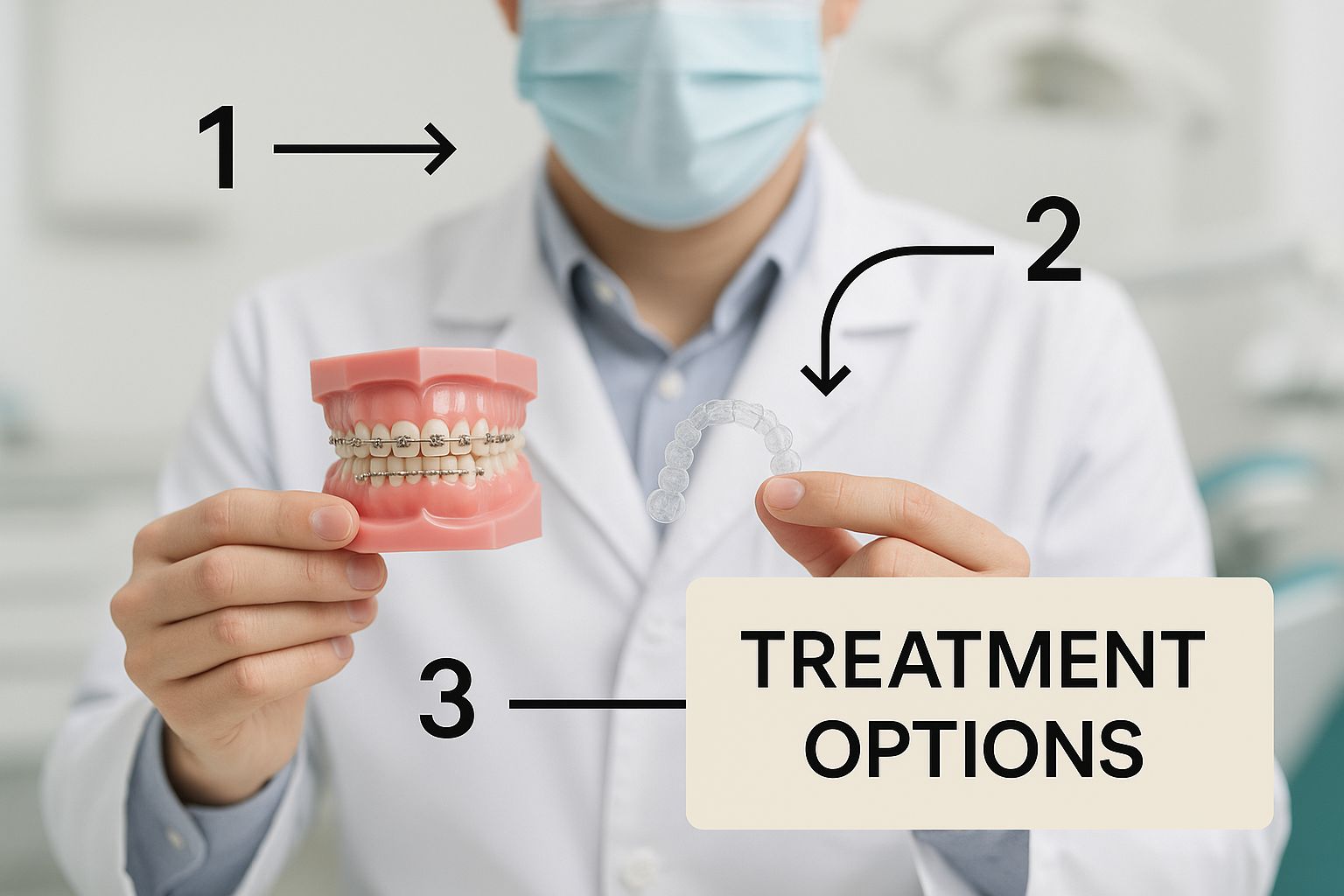
As you can see, patients have clear choices, from traditional fixed braces to the more discreet clear aligners, each with a unique approach to achieving a straighter smile.
Living with Your Aligners
With your personalised treatment plan approved, your full set of custom-made aligners is produced and delivered. You’ll receive a series of individually numbered trays, each one slightly different from the last. The plan is simple: you wear each tray for about one to two weeks before moving on to the next in the sequence.
For the treatment to work its magic, commitment is key. You’ll need to wear your aligners for 20-22 hours a day. That means keeping them in while you sleep, work, and go about your daily life, only popping them out to eat, drink anything other than plain water, or clean them.
When you first switch to a new aligner, you’ll probably feel a bit of pressure or tightness. That’s a good thing! It’s the aligner actively working, gently nudging your teeth into position. This feeling usually subsides after a day or so as your teeth get used to it. Most people find it’s far more comfortable than the regular tightening appointments that come with traditional braces.
Keeping them clean is a doddle, too—just a gentle brush with a soft toothbrush and cool water does the trick. It’s a convenient, professionally supervised process that shows just how achievable fixing crowded teeth really is today.
How to Choose the Right UK Orthodontic Provider
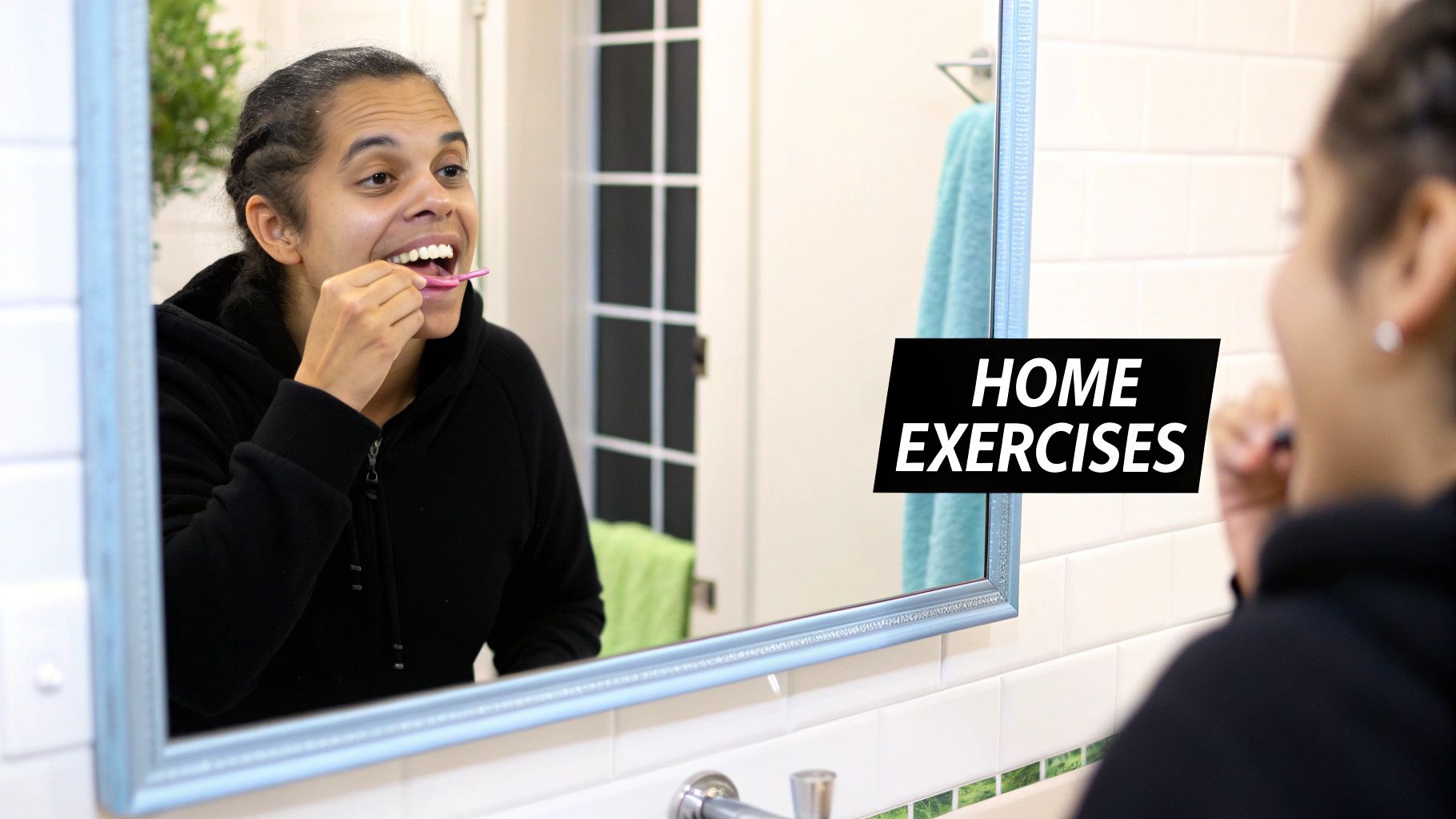
Deciding on the right treatment is a great first step, but it’s only half the battle. Who you trust with your smile is just as important, and feeling confident in that choice means knowing what to look for and who you’re really working with.
In the UK, you’ll generally find two types of professionals: general dentists and specialist orthodontists. Many brilliant dentists offer teeth straightening services. However, it’s worth knowing that an orthodontist has completed several extra years of focused training on one thing and one thing only: aligning teeth and jaws. For more complex crowding, that specialised expertise can make all the difference.
But the old ways aren’t the only ways. A new approach has emerged, blending professional oversight with incredible convenience. Modern providers, like Toothfairy, connect you directly with registered UK dentists who personally design and monitor your entire clear aligner treatment. This model gives you a smart, affordable alternative to some specific aligner brands without ever cutting corners on professional supervision—a critical element for getting the results you want safely. It’s a world away from direct-to-consumer brands that operate without this crucial dental oversight, which is a risk not worth taking.
Vetting Your Potential Provider
Think of your initial consultation as an interview. You’re the one in the driver’s seat, so come prepared with questions. A good, transparent provider will have no problem giving you clear, direct answers.
Here are a few non-negotiable questions I always recommend asking:
- Who is actually planning and supervising my treatment? You need to confirm that a registered UK dentist or orthodontist is personally responsible for your case from start to finish.
- What is the total, all-in cost? Get an itemised quote that covers everything: the initial scans, every single aligner, any potential mid-course corrections, and your final retainers. No hidden extras.
- What technology are you using? Do they use accurate 3D digital scans? How will they show you what your teeth are predicted to look like at the end?
- What happens if something doesn’t feel right? Make sure you understand their process for support. How easy is it to get in touch with someone if you have a concern during your treatment?
A great provider isn’t just selling you a product; they’re offering a complete service. This means transparent pricing, clear communication, and dedicated support from a qualified professional throughout your entire journey.
Checking Their Digital Reputation
These days, a provider’s online presence can tell you a huge amount. Before you commit, spend a few minutes doing your own digging. Look for genuine patient reviews on independent sites like Google or Trustpilot. What you’re looking for aren’t just five-star ratings, but also how the provider responds to feedback—both good and bad. It’s a real window into their commitment to patient care.
A solid digital footprint is usually a sign of a modern, patient-first practice. In fact, research into UK dental services reveals just how much a provider’s online presence influences patient decisions. For instance, practices that land in the top three Google Map results pull in 67% of local orthodontic searches. What’s more, those with over 50 Google reviews can see a 73% higher click-through rate. It’s clear proof that a strong online reputation builds real-world trust. You can read more about how online presence affects patient choice to see why it’s such a reliable indicator of quality.
Keeping Your New Smile Straight After Treatment
That moment you finish your orthodontic treatment is a huge milestone. You’ve done the work, you’ve been patient, and now you can finally show off the straight smile you’ve been waiting for. But here’s something I always tell my patients: fixing crowded teeth for good doesn’t stop when the aligners come off. The next phase, what we call retention, is every bit as important for making sure your results last.
Think about it this way: your teeth aren’t just stuck in bone. They’re held in place by tiny, elastic ligaments. Over months, your aligners have gently stretched these ligaments to guide your teeth into their new, straighter positions. Once that pressure is gone, the natural instinct for those ligaments is to pull back, trying to shift your teeth right back where they started. This is called orthodontic relapse, and it’s a lot more common than people realise.
The Role of Your Retainer
This is where your retainer becomes your best friend. Honestly, it’s the single most vital tool for locking in all that time and investment. It acts like a guard, holding your teeth in their new formation while the bone and gums around them have time to solidify. Skipping your retainer is the fastest way to see all your progress unravel.
Your orthodontist will typically recommend one of two types, or sometimes a combination of both.
- Removable Retainers: You’ll probably recognise these – they look a lot like the clear aligners you’ve just finished wearing. They’re custom-made to fit your teeth perfectly. Their biggest plus is that you can pop them out for meals and for brushing and flossing, which makes keeping your teeth clean a breeze.
- Fixed Retainers: This is a very fine, subtle wire that gets bonded behind your front teeth, most often the bottom ones. From the front, it’s completely invisible. The beauty of a fixed retainer is that it provides round-the-clock protection without you ever having to remember it.
It’s quite common to get a fixed retainer on your lower teeth and a removable one for the top arch. Your dentist will walk you through what makes the most sense for your specific case.
The first few months after your treatment are the most high-risk time for movement. You’ll almost certainly be asked to wear your removable retainer full-time (taking it out only to eat and clean your teeth), before eventually switching to night-time wear only.
Making Retainer Wear a Lifelong Habit
The secret is to weave your retainer into your daily routine until it becomes second nature. A great tip is to keep its case right next to your toothbrush, which serves as a perfect visual reminder to put it in before you go to sleep.
And always, always have the case with you when you’re out. You would not believe how many retainers get accidentally wrapped in a napkin at a restaurant and thrown away. It happens all the time!
Modern providers like Toothfairy build this guidance right into their process, making sure you get the right kind of retainers and a clear schedule for wearing them. This follow-up care is a core part of how to fix crowded teeth permanently, not just temporarily. By making your retainer a non-negotiable part of your life, you’re making sure that fantastic new smile is here to stay.
Your Questions on Fixing Crowded Teeth Answered
Deciding to straighten your teeth is a big step, and it’s only natural to have a few questions swirling around. Getting clear, honest answers is the key to feeling confident about your decision. Let’s walk through some of the most common queries we hear from people just starting their journey to a straighter smile.
Is Fixing Crowded Teeth Painful?
This is probably the number one concern for most people. With modern clear aligners, the experience is much different from what you might imagine. You should expect some mild pressure or a feeling of tightness, especially for the first day or two after you pop in a new aligner tray.
Honestly, this feeling is a good thing—it’s the sign that your teeth are gently and precisely moving into place. Most people describe it as a dull ache, not a sharp pain, and it’s worlds away from the discomfort often associated with tightening traditional metal braces. This sensation is very manageable and usually disappears quickly as your mouth gets used to the new aligner.
What Is the Cost of Treatment in the UK?
The investment needed to fix crowded teeth can vary quite a bit. The final figure really comes down to how much work is needed and the type of treatment you go for. For traditional fixed braces, you could be looking at anywhere from £2,500 to £5,000, and sometimes more, depending on the specialist and where you are in the country.
At Toothfairy, we’ve worked hard to make treatment more accessible. We focus on transparent pricing and offer straightforward payment plans to help spread the cost. My best advice? Always get a detailed quote that breaks down every single cost, from the initial consultation right through to your final retainers. That way, you know exactly what you’re paying for, with no hidden surprises.
A key takeaway is that you are never too old for orthodontic treatment. In fact, a growing number of UK adults are choosing to straighten their teeth, recognising it as an investment in both their appearance and long-term oral health.
Am I Too Old for Orthodontics?
It’s a complete myth that braces are just for teenagers! The truth is, as long as your teeth and gums are healthy, age is rarely a barrier to getting the smile you want. You are very likely a fantastic candidate for treatment.
Straightening crowded teeth as an adult isn’t just about aesthetics, either. It makes cleaning your teeth so much easier, which dramatically lowers your risk of gum disease and decay down the line. To feel fully prepared, exploring effective patient education resources can give you the knowledge and confidence you need. Taking a proactive approach ensures you feel in control of your treatment every step of the way.
Ready to take the next step towards a straighter, healthier smile? With Toothfairy, you can start your journey with a simple online assessment, guided by registered UK dentists. Discover a smarter, more affordable way to fix crowded teeth from the comfort of your home. Learn more and get started today!
Last updated on August 19, 2025

Toothfairy Care Team
Toothfairy, is the world's smartest dental app, that connects patients to a dentist for a range of issues, from emergencies, cosmetics, prescriptions to virtual exams.
Toothfairy Care Team
Toothfairy, is the world's smartest dental app, that connects patients to a dentist for a range of issues, from emergencies, cosmetics, prescriptions to virtual exams.
